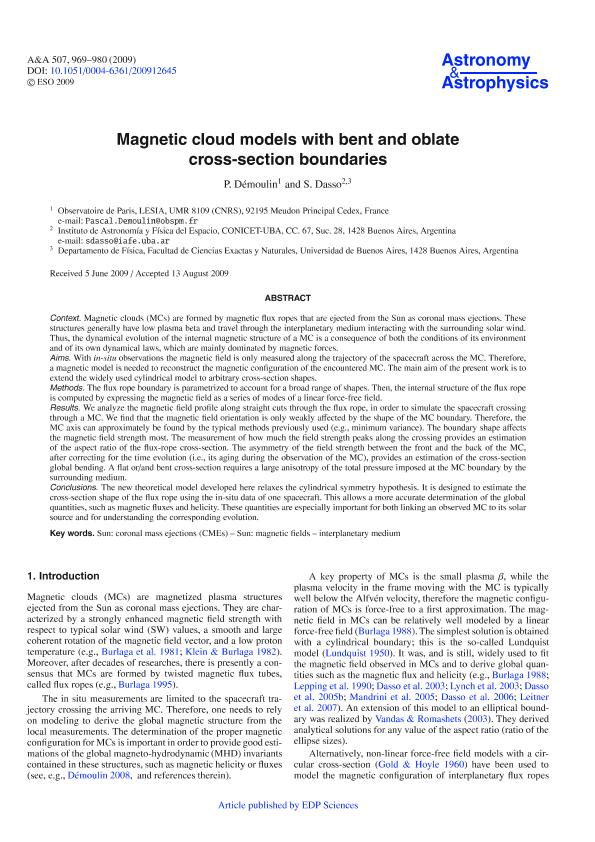Artículo
Magnetic cloud models with bent and oblate cross-section boundary
Fecha de publicación:
15/09/2009
Editorial:
EDP Sciences
Revista:
Astronomy and Astrophysics
ISSN:
0004-6361
Idioma:
Inglés
Tipo de recurso:
Artículo publicado
Clasificación temática:
Resumen
Context. Magnetic clouds (MCs) are formed by magnetic flux ropes that are ejected from the Sun as coronal mass ejections. These structures generally have low plasma beta and travel through the interplanetary medium interacting with the surrounding solar wind. Thus, the dynamical evolution of the internal magnetic structure of a MC is a consequence of both the conditions of its environment
and of its own dynamical laws, which are mainly dominated by magnetic forces.
Aims. With in-situ observations the magnetic field is only measured along the trajectory of the spacecraft across the MC. Therefore, a magnetic model is needed to reconstruct the magnetic configuration of the encountered MC. The main aim of the present work is to extend the widely used cylindrical model to arbitrary cross-section shapes. Methods. The flux rope boundary is parametrized to account for a broad range of shapes. Then, the internal structure of the flux rope is computed by expressing the magnetic field as a series of modes of a linear force-free field.
Results. We analyze the magnetic field profile along straight cuts through the flux rope, in order to simulate the spacecraft crossing through a MC. We find that the magnetic field orientation is only weakly affected by the shape of the MC boundary. Therefore, the MC axis can approximately be found by the typical methods previously used (e.g., minimum variance). The boundary shape affects
the magnetic field strength most. The measurement of how much the field strength peaks along the crossing provides an estimation of the aspect ratio of the flux-rope cross-section. The asymmetry of the field strength between the front and the back of the MC, after correcting for the time evolution (i.e., its aging during the observation of the MC), provides an estimation of the cross-section global bending. A flat or/and bent cross-section requires a large anisotropy of the total pressure imposed at the MC boundary by the surrounding medium. Conclusions. The new theoretical model developed here relaxes the cylindrical symmetry hypothesis. It is designed to estimate the cross-section shape of the flux rope using the in-situ data of one spacecraft. This allows a more accurate determination of the global
quantities, such as magnetic fluxes and helicity. These quantities are especially important for both linking an observed MC to its solar source and for understanding the corresponding evolution.
Palabras clave:
Solar Wind
,
Magnetic Clouds
Archivos asociados
Licencia
Identificadores
Colecciones
Articulos(IAFE)
Articulos de INST.DE ASTRONOMIA Y FISICA DEL ESPACIO(I)
Articulos de INST.DE ASTRONOMIA Y FISICA DEL ESPACIO(I)
Citación
Démoulin, Pascal; Dasso, Sergio Ricardo; Magnetic cloud models with bent and oblate cross-section boundary; EDP Sciences; Astronomy and Astrophysics; 507; 2; 15-9-2009; 969-980
Compartir
Altmétricas




